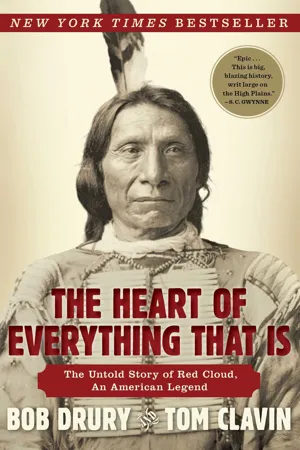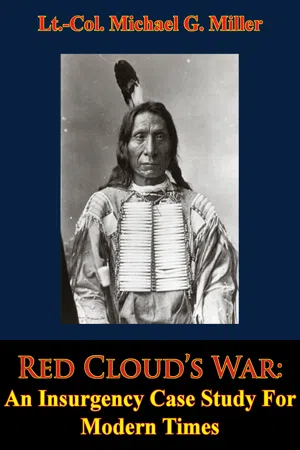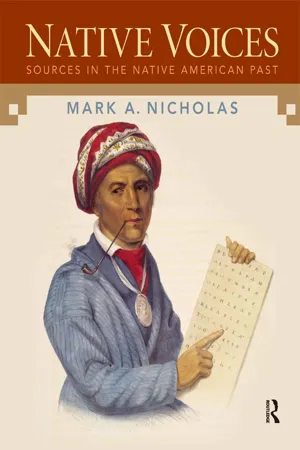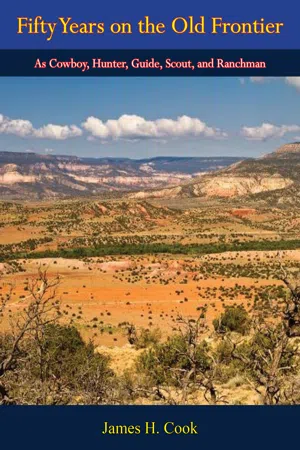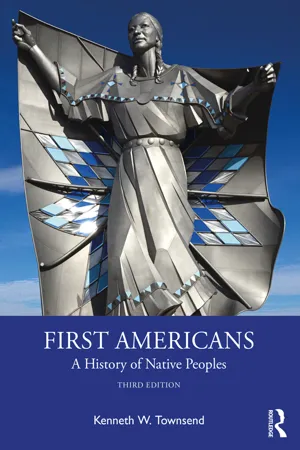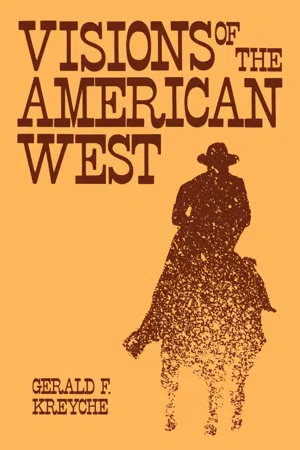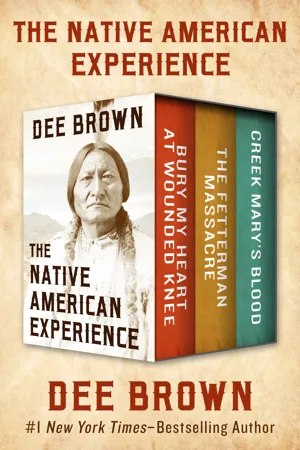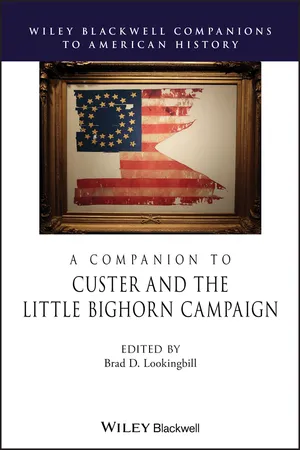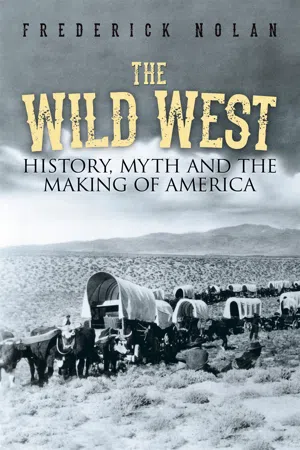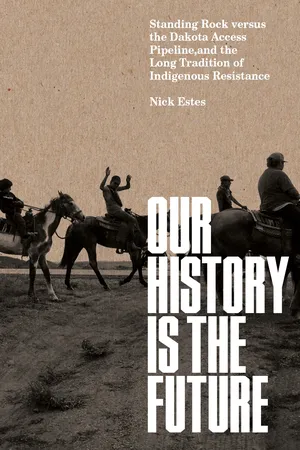History
Red Cloud's War
Red Cloud's War was a conflict between the United States and the Native American Lakota Sioux tribe in the 1860s. Led by Chief Red Cloud, the Sioux successfully resisted the US military's attempts to build forts and roads in their territory. The war ultimately led to the signing of the Treaty of Fort Laramie in 1868, which granted the Sioux control over the Black Hills.
Written by Perlego with AI-assistance
Related key terms
Related key terms
1 of 4
Related key terms
1 of 3
11 Key excerpts on "Red Cloud's War"
- eBook - ePub
The Heart of Everything That Is
The Untold Story of Red Cloud, An American Legend
- Bob Drury, Tom Clavin(Authors)
- 2013(Publication Date)
- Simon & Schuster(Publisher)
The mean, small structure, erected in 1834 and initially named Fort William, was the only American trading post west of the Missouri. Situated at the juncture of the Laramie and the North Platte in southeastern Wyoming, about midway between present-day Cheyenne and Casper, it was the brainchild of an Irish-born mountain man, Robert Campbell, and was named after his trigger-happy partner, William Sublette, who was said to have fled the mountains after initiating the slaughter of a band of peaceful Gros Ventres during the annual mountain man rendezvous of 1832. Campbell and Sublette had trapped in the Rockies for over a dozen years, and both recognized by the mid-1830s that the European craze for beaver hats was dying. The new money would be made in buffalo robes, and the two did a thriving business, especially with the Lakota, whose superior tanned hides of buffalo cows were craved by the merchants in St. Louis. (Bull hides were deemed of lesser quality.)Fort William, protected by a fifteen-foot palisade of cottonwood logs and a cannon mounted in a blockhouse over the front gate, became a regular winter transit point for Indians meandering across the Powder River Country. White-Indian interactions were generally peaceable. Given their isolation and small numbers, the two mountain men and the few teamsters they employed did not have much of a choice. The Indians, meanwhile, not only wanted and needed the dry goods they imported, but saw no glory to be gained by wiping them out. They were, after all, merely whites. The Lakota, in any case, were still busy with the broader pursuits of their Plains expansionism, raiding and fighting the Crows, Ute, Pawnee, and Kiowa at every opportunity.Once they took a territory, the Sioux patrolled it ruthlessly. This philosophy of security through aggression naturally filtered down to individuals, for whom military glory became a stepping-stone to leadership. It was impossible to become a Sioux leader without also being a distinguished warrior, and no one was more prepared to seize the mantle and the rewards that came with it than Red Cloud. The most important of these rewards was social advancement. “When I was young among our nation, I was poor,” he told Sam Deon. “But from the wars with one nation or another, I raised myself to be a chief.”A warrior’s vocation was the only path to success and stature for a fatherless boy, even a boy with powerful and respected uncles. Red Cloud was about sixteen years old when he joined his first raiding party. It was sometime in the late 1830s, and the Lakota were waging a war of attrition against the Pawnee, who dwelled in stationary earth lodges and whose territory in east-central Nebraska was dwindling precariously. One day after a rare unsuccessful raid on a Pawnee stronghold along the twisting Platte, word spread through the Oglala camp that Red Cloud’s older cousin had been killed in the fight. The horror of losing a battle to the lowly Pawnee turned to cold fury, and Old Smoke organized an even larger retaliatory force from among several Lakota bands camping nearby. Red Cloud had always, if reluctantly, obeyed the pleas of his mother when she argued that he was too young to take part in these raids. Despite a Sioux woman’s inferior status, Walks As She Thinks did speak with some authority due to her brothers’ standing. But even the respect afforded Old Smoke and White Hawk could not alter the fact that Red Cloud’s absence from the war parties was beginning to be remarked on. - Lt.-Col. Michael G. Miller(Author)
- 2015(Publication Date)
- Normanby Press(Publisher)
{43}The Army takes the Trail
Ft. Laramie was the “center of important interests to the people of the West” in June 1866.{44} The Ft. Laramie Peace Commission was an effort by U.S. government and the Indian Commission to gain Indian approval for movement along the Bozeman Trail, and for the U.S. Army garrisons there to protect the Immigrants. If this Peace Commission had been successful in getting the approval from all the tribes involved, there is little doubt that later tragedies would have been avoided. Instead, Margaret Carrington said that the failure of the treaty and Red Cloud’s departure in anger held, “ominous portents for the future.”{45} She was referring to the extremely difficult tasks of building new forts, securing the trail and ensuring safe movement with a command that was “barely sufficient to do its expected work on the basis of permanent and reliable peace,” let alone in hostile Indian Country.{46}On June 17, 1866 Carrington’s long column departed Ft. Laramie with the eight companies of the 2nd Battalion of the 18th Infantry and its 226 wagon train, taking possession of the trail with the first destination being Ft. Reno.{47} What’s important here is not the obvious spectacle of such a large train hitting the trail in all its pomp and glory, but what was missing. Why the force was predominately infantry instead of cavalry is unknown. Against this mobile enemy, General Sherman himself remained convinced that, “cavalry is the most efficient arm of the service for existing conditions in Indian Country.”{48} While at Ft. Laramie, Carrington had made repeated requests of the post commander for his promised 100,000 rounds ammunition, horses and wagon drivers. But the requests fell on deaf ears, and were never to be had. The fact is that he departed with just a fraction of what had been promised, and what they needed to properly perform the task they were ordered to. This would be a reoccurring problem for Carrington and his men in the Powder River Campaign.{49}- eBook - ePub
Native Voices
Sources in the Native American Past
- Mark Nicholas(Author)
- 2016(Publication Date)
- Routledge(Publisher)
Pahá Sápa, was the central geological feature within the sacred landscape of the Sioux. The importance of the Black Hills to the Sioux cannot be overstated.In the 1870s, the northern plains’ war broke out again between the Sioux and the United States, and the Black Hills was central to the struggle known as the Great Sioux War, waged from 1876 to 1877. The earnestness on both sides during the war had everything to do with the Black Hills territory and conflicting ideas about the region’s significance: For the Sioux, it was their land, and it was sacred; for American prospectors, it was an untouched area from which to harvest gold. The United States, in the midst of an economic crisis and ineffective at keeping western fortune seekers looking for gold from entering the Black Hills, abrogated Sioux treaty rights to the Black Hills, agreed upon in the second Fort Laramie Treaty of 1868. The Sioux, responding to the transgressions of the United States, factionalized. Ordered to move to their reserved tracts by the United States, the Sioux responded in two ways. Red Cloud and his followers accommodated and settled near the Red Cloud agency, a precursor to the Sioux reservations, located along the Platte River, just south from Fort Laramie. Red Cloud agency, staffed by American field agents, doled out weekly rations and annuity payments to Red Cloud and his Oglala followers. The militant Sioux led by Sitting Bull (Hunkpapa Lakota Sioux) and Crazy Horse (Oglala Lakota Sioux) stalwartly refused, and the Sioux under their leadership went to war with the United States. In a tactical maneuver to try for a swift victory over the Sioux, the United States turned to Crow and Shoshone warriors whose enmity against their Sioux rivals stretched back generations, and who were emboldened by the idea of eliminating the Sioux to elevate their own status and power on the plains. Both Crow and Shoshone warriors therefore joined the ranks of General George Armstrong Custer’s army. - eBook - ePub
Crazy Horse and Custer
The Parallel Lives of Two American Warriors
- Stephen E. Ambrose(Author)
- 2014(Publication Date)
- Open Road Media(Publisher)
Friendly Indians, mainly young Brulés, made a regular run between Fort Laramie and the hostile camp, bringing ammunition and other supplies with them; on the return trip they carried buffalo robes for which they found a ready market among the traders. Occasional hunting parties provided more meat than the hostiles could use. In every respect, in short, Red Cloud supported and equipped his army better than the government supported Carrington. 15 When winter came on, Red Cloud moved the allied camp to the base of the Bighorns, near the headwaters of the Tongue River, where he found shelter in the cold weather and from which he could send war parties out against Fort Phil Kearny on clear days. Following one last big buffalo hunt, Red Cloud prepared to rub out the garrison. He now had over five hundred lodges of Indians gathered together, including a few Gros Ventres; the camp covered a forty-mile stretch of the Tongue Valley. There were smaller camps along the Powder River. In all, Red Cloud had a thousand or more warriors on active duty. For the final offensive, he called up his reserves—the young Brulés and Hang-Around-the-Forts who ordinarily spent the winter at or near the agencies, coming to the Powder River country only during the summer. But in December of 1866, Red Cloud had most of these youngsters with him, swelling the ranks of the hostiles by perhaps as many as a thousand additional warriors. Crazy Horse and his fellow shirt-wearers knew that they could not hope to destroy the whites, despite a nearly six-to-one superiority, unless they could draw a portion of Carrington’s command into the open. All the soldiers had single-shot rifles, while only a handful of warriors possessed firearms. But if a large number of soldiers could be lured into the open, where the Indians could fire volleys of arrows at them or overwhelm them by sheer numbers, using clubs and spears as the principal weapons, something significant could be accomplished - eBook - ePub
Fifty Years on the Old Frontier
As Cowboy, Hunter, Guide, Scout, and Ranchman
- James H. Cook(Author)
- 2019(Publication Date)
- Papamoa Press(Publisher)
In the 1876 campaign Red Cloud took little if any part. Many warriors from the Red Cloud Agency, however, were with the hostiles, and several old Indians who took part in the fight with Custer’s command, and who have visited me in company with Red Cloud, have told me of the day when they wiped out the courageous general and so many soldiers. Their victory, as they well knew, was due only to their overwhelming numbers and to the fact that the cavalrymen were forced to fight on foot. Red Cloud well knew at this time that war with the whites could result in nothing but suffering and death to many of his people; but he had lost control of many of the bands of Sioux, and they would not heed his pacific suggestions. Some of his sub-chiefs—for example, Crazy Horse—and many of the young men wanted war, and they had to have it. Red Cloud’s popularity waned as others who were more belligerent led the young men on the war trails against the “long knives.” Bad wounds and old age may have had a great deal to do with checking Red Cloud’s warlike spirit at this time; but his judgment in laying down the hatchet at the time when he forsook the warpath was, I think, greater than that of his sub-chief Crazy Horse, who had to make his start for the ghost trail off the point of a bayonet thrust by an unduly excited soldier. When Crazy Horse was killed at Fort Robinson after having been summoned there for a talk with government officials, many of his people felt that it was a most treacherous and cowardly deed, and great efforts were required on the part of Red Cloud and other old men to restrain the warriors from attempting to avenge his death.In 1878, when the band of Northern Cheyennes who had been held as prisoners of war at Fort Reno, Indian Territory, broke loose and fought their way back north as far as Red Cloud’s country, their leaders (considered by both the white and the red men who knew them to be the bravest and shrewdest Indian war chieftains who ever lived on our western plains within the history of man) tried their best to persuade Red Cloud and his old sub-chiefs to join them in making a last stand, urging that it would be better to die the death of warriors than be obliged to live like dogs—to be fed such refuse as white men might see fit to give, and to be told where they might and might not go. Red Cloud, however, would not listen to their war talk, and he did everything he could to have the Sioux remain quiet and let the war trail grass over.The next so-called Sioux uprising took place in the autumn and winter of 1890-1891. It was caused by the Messiah craze that came to them by way of runners from the Far West. Word had come from the Great Spirit of all Indians that the hated white man was to be wiped off the earth, and that former conditions, such as the return of the buffalo, would follow. They were to dance and pray until such conditions came to pass. The effect of these messages was like that of the arrival and efforts of a great revivalist of the shouting Methodist school, who could soon have great numbers of blind followers under the influence of what he styled “the power.” - eBook - ePub
- Kenneth W. Townsend(Author)
- 2023(Publication Date)
- Routledge(Publisher)
The Earth Is Weeping: The Epic Story of the Indian Wars for the American West (New York: Alfred A. Knopf, 2016). A solid treatment of the Sioux wars for survival, relying heavily on the words of Native Americans and representatives of the United States government at that time.- Drury, Bob, and Tom Clavin. The Heart of Everything That Is: The Untold Story of Red Cloud, and American Legend. (New York: Simon & Schuster, 2013). Based on Red Cloud’s own testimony, this work offers a comprehensive and compelling story of the Oglala Sioux warrior in the defense of his people and nation.
- Gardner, Mark Lee. The Earth Is All That Lasts: Crazy Horse, Sitting Bull, and the Last Stand of the Great Sioux Nation (Boston, MA & New York: Mariner Books, 2022). A life study of two icons of Native American history that provides greater understanding of their individual roles in resisting westward expansion and waging war when necessary against the U.S. Army during the Great Sioux War of 1876.
- Greene, Jerome. Washita: The U.S. Army and the Southern Cheyenne, 1867–1869 (Norman: University of Oklahoma Press, 2008). A thorough study of the causes, conduct, and results of the massacre of Cheyenne at the Washita Valley. Greene argues in part that this event contributed directly to the defeat of Custer at Little Big Horn years later.
- Hedren, Paul L. Powder River: Disastrous Opening of the Great Sioux War (Norman: University of Oklahoma Press, 2016).
- Marshall, Joseph. The Day the World Ended at Little Big Horn: A Lakota History (New York: Viking, 2006). A thoughtful analysis of the Greasy Grass Fight (Little Big Horn) that examines combat strategy, sources of the Indians’ victory, and post-battle consequences, with emphasis on the Indians’ perspective.
- Monnett, John H. Where a Hundred Soldiers Were Killed: The Struggle for the Powder River Country in 1866 and the Making of the Fetterman Myth
- eBook - ePub
- Gerald F. Kreyche(Author)
- 2021(Publication Date)
- The University Press of Kentucky(Publisher)
In 1865, a number of Indians made concessions to that end and, in 1866, an attempt was made to reach universal agreement. Runners were sent out from Fort Laramie inviting all concerned Indians to another council at the fort. It was hoped that the “bad faces”—those who didn’t agree to the previous concession—would come as well. The council began on June 1, 1866, but the great Chief Red Cloud, the most important of the “bad faces,” refused to come. Coinciding with the opening of the council, there arrived from the East a large army headed by Colonel Henry Carrington, an engineering expert. He brought “a train of 226 mule teams . . . loaded with equipment and supplies, including a saw mill, mowing machines, shingle and brick machines, blacksmith and harness-making equipment, axes, saws and tools of all kinds. There were rocking chairs, churns, quantities of canned fruit, turkeys, chickens, pigs and cows.”—and a thirty-piece brass band. 20 His mission was to strengthen existing forts and to build new ones along the Bozeman to protect its patrons. Meanwhile, Red Cloud changed his mind and came, more as an observer than a participant. What he observed he did not like. He felt that Carrington’s force once again argued the duplicity of the white man who, while giving gifts and forcing concessions through a treaty, was planning to put down the Indian whether or not the treaty was signed. Both Red Cloud and Man Afraid Of His Horses refused to sign. Margaret Carrington, wife of the colonel, reported that before leaving with warriors loyal to him, Red Cloud complained publicly: “Great father sends us presents and wants new road, but white chief goes with soldiers to steal road before Indians say yes or no!” 21 Colonel Carrington began to have some inkling of what to expect as he carried out his mission - eBook - ePub
The Native American Experience
Bury My Heart at Wounded Knee, The Fetterman Massacre, and Creek Mary's Blood
- Dee Brown(Author)
- 2017(Publication Date)
- Open Road Media(Publisher)
On December 6, a day with a cold wash of air flowing down the slopes of the Bighorns, High Back Bone and Yellow Eagle took about a hundred warriors and dispersed them at various points along the pinery road. Red Cloud was with another group of warriors who took positions along the ridgetops. They flashed mirrors and waved flags to signal the movements of the troops to High Back Bone and his decoys. Before the day was over, the Indians had the Bluecoats dashing about in all directions. At one time the Little White Chief Carrington came out and gave chase. Choosing just the right moment, Crazy Horse dismounted and showed himself on the trail in front of one of Carrington’s hot-blooded young cavalry officers, who immediately led a file of soldiers galloping in pursuit. As soon as the soldiers were strung out along the narrow trail, Yellow Eagle and his warriors sprang from concealment in their rear. In a matter of seconds the Indians swarmed over the soldiers. (This was the fight in which Lieutenant Horatio Bingham and Sergeant G. R. Bowers were killed and several soldiers severely wounded.)In their camps that night and for several days following, the chiefs and warriors talked of how foolishly the Bluecoats had acted. Red Cloud was sure that if they could entice a large number of troops out of the fort, a thousand Indians armed with only bows and arrows could kill them all. Sometime during the week, the chiefs agreed that after the coming of the next full moon they would prepare a great trap for the Little White Chief and his soldiers.By the third week of December everything was in readiness, and about two thousand warriors began moving south out of the lodges along the Tongue. The weather was very cold, and they wore buffalo robes with the hair turned in, leggings of dark woolen cloth, high-topped buffalo-fur moccasins, and carried red Hudson’s Bay blankets strapped to their saddles. Most of them rode pack horses, leading their fast-footed war ponies by lariats. Some had rifles, but most were armed with bows and arrows, knives, and lances. They carried enough pemmican to last several days, and when an opportunity offered, small groups would turn off the trail, kill a deer, and take as much meat as could be carried on their saddles. - Brad D. Lookingbill, Brad D. Lookingbill(Authors)
- 2015(Publication Date)
- Wiley-Blackwell(Publisher)
Crazy Horse and Custer: The Parallel Lives of Two American Warriors (1975) so closely mirrored Sandoz’s narrative that at times it is difficult to tell the two apart, even though Ambrose openly questioned Sandoz’s methodology and her use of oral interviews (Ambrose 1975, 134, 487). Despite their similarities, Ambrose’s account differed from Sandoz’s work in several ways. He suggested that the affair between Crazy Horse and Black Buffalo Woman did not just cause embarrassment and disgrace for Crazy Horse but was one of the major factors that created a division among the Oglala. To Ambrose, the affair created a rift between Crazy Horse and Red Cloud that culminated in Red Cloud’s signing of the Treaty of Fort Laramie in 1868 (Ambrose 1975, 338–402, 506 fn. 23). This marked a turning point for Red Cloud, who had been a fierce opponent of white expansion in throughout the 1860s; after 1868, however, he was conciliatory toward whites. He worked closely with them to bring the Lakota to the agencies, which increased his stature with American officials and made him the most powerful Indian leader on the reservation. Red Cloud’s status as the most influential Oglala was directly challenged by Crazy Horse’s refusal to surrender, because his continued resistance inspired off-reservation Indians to continue the fight and emboldened others – especially young warriors – to reject the influence of Red Cloud and other moderates, to leave the agencies, and to join the Northern Nation in their defense of Indian culture. While Sandoz portrayed Crazy Horse as an important war chief, she did not fully explain his importance to the Indian victory at the Battle of the Little Bighorn. Ambrose insisted that Crazy Horse’s military prowess made him a military commander, who directed the movements of warriors across the entire battlefield (Ambrose 1975, 225–231).Historian Mike Sajna offered the first major corrective to Sandoz’s work. His revisionism stemmed largely from the sources Sandoz used and the way they influenced her account (Sajna 2000, ix). Sajna rejects Sandoz’s depiction of a long courtship between Crazy Horse and Black Buffalo Woman, pointing out that none of the interviews or written accounts taken from eyewitnesses had confirmed an earlier relationship between them (Sajna 2000, 157–158). Where Sandoz offered no deeper explanation of Crazy Horse’s reserved demeanor, Sajna suggests that it was the product of several traumatic incidents from his childhood, particularly the suicide of his mother when he was a young boy. Her death and the circumstances that surrounded it – Crazy Horse’s father, Worm, had a brother who was killed in combat against an enemy tribe and Crazy Horse’s mother killed herself upon hearing the news – likely haunted him for the rest of his life (Sajna 2000, 25–27). Sajna also suggests that Crazy Horse’s reserved nature and desire to become a fierce warrior could have resulted from the ridicule he received from other Lakota children because of his fair complexion (Sajna 2000, 28–29). He dismisses Crazy Horse’s ties to the Cheyenne, a main point that drove Sandoz’s narrative, because those connections are not supported by the sources (Sajna 2000, 123, 171). At the Battle of the Little Bighorn, Sajna believes that Crazy Horse realized that his greatest value to the Lakota was as a leader and knew that reckless charges into the enemy line would therefore jeopardize the welfare of his people. As a result, he attacked the enemy lines when only a few soldiers remained (Sajna 2000, 285–288). The fundamental flaws of Sajna’s work are similar to those with Adams’s book on Sitting Bull, that is, the tendency of Euro-American academics to disregard the value of natives’ oral tradition. While oral histories and interviews taken after a significant passage of time do need to be examined with a measure of caution and corroborated whenever possible, the suggestion that oral tradition is more fallible than so-called “traditional” written sources veers dangerously toward “history by the victors” – a paradigm that has become passé in recent years.- eBook - ePub
The Wild West
History, myth & the making of America
- Frederick Nolan(Author)
- 2019(Publication Date)
- Arcturus(Publisher)
Little Crow, who had fled to Canada with some of his people, unwisely decided in June of the following year to return to Minnesota to steal horses; he seems not to have known that the state had instituted a bounty for Sioux scalps. On the afternoon of 3 July 1864, farmer Nat Lampon and his son Chauncey, out hunting, spotted Little Crow and his son picking raspberries and (although he had no idea who they were) opened fire, killing Little Wolf. The state presented the hunters who had killed him with the promised bounty of $25 plus a bonus of five hundred dollars. The old chief’s son learned later that his father’s scalp and skull had been placed on display in St Paul.Little Crow’s ‘war’ was in many ways a template of all the ‘wars’ between the Native American tribes and the white man that followed: there would not be a single State or Territory west of the Mississippi that did not experience one. The only difference between them was one of scale. Everywhere the sheer volume of white expansion forced the two sides into more and more contact, with increasingly violent reactions on the part of the Indians as they resisted the advance.That such resistance was doomed from the start, the Indians could not know; but it was. Not only were the Indians comprehensively outnumbered and catastrophically outgunned but also because of the very nature of their concept of warfare. In almost every tribe there existed a cult of bravery, one that considered individual acts of courage or cunning far more admirable than mere killing. Their inter-tribal wars were a state of permanent hostility punctuated by raids to capture booty and to exhibit courage; because symbolic death –‘counting coup’ by touching an enemy with a stick and escaping unharmed – was valued far more than killing an enemy, deaths in battle were comparatively few. It was a concept the white man never could and never would understand. Their outlook was brutally pragmatic: dead men don’t shoot back.So in Colorado, when white settlers became convinced the local Arapaho and Cheyenne were only waiting for their opportunity to attack them, as Little Crow had attacked the settlements of Minnesota, white leaders reacted quickly. Prominent among these was a former Methodist minister named John Milton Chivington (1821-1894). A hero of the war against the Confederates in New Mexico who had been named commander of the Military District of Colorado, Chivington was, it was said, keen to run for Congress and anxious to earn promotion to the rank of brigadier general. - eBook - ePub
Our History Is the Future
Standing Rock Versus the Dakota Access Pipeline, and the Long Tradition of Indigenous Resistance
- Nick Estes(Author)
- 2019(Publication Date)
- Verso(Publisher)
42 The intention behind the treaties was not to recognize the inherent political sovereignty or self-determining authority of Indigenous nations, but to facilitate land cessions and eventual incorporation. Justifying what would otherwise be a criminal act—invasion—the treaties were really an instrument for affirming US design over all lands, and especially lands that could not be taken by force. And to carry out the land cessions, the US government needed settlers to hold private property in perpetuity. Private ownership (or “fee simple”) is seen, under US law, as the highest possible form of ownership, while Indigenous occupancy is seen as temporary; thus, collective Indigenous ownership and use could be dissolved for private ownership, but not the other way around. But because private property is exclusive, the two systems of land tenure fundamentally could not overlap. The confinement and removal of Indigenous peoples to reservations was racial segregation, and Indigenous peoples were the original “Red Scare.”It was from this belief of political superiority that the United States sued the Oceti Sakowin for peace. As a token of good will, the United States abandoned several forts along the Bozeman Trail, and Red Cloud and his followers set fire to the deserted buildings. The forts on the Missouri River, however, remained untouched and became the new bases of operations for corralling the Oceti Sakowin closer to the influence of the United States, and away from the Powder River country which more and more represented freedom.43 The 1868 Fort Laramie Treaty established a 32-million-acre “permanent reservation,” which encompassed the entirety of the present-day West River region of South Dakota. To appease those who refused agency life, a vast expanse of hunting grounds was set aside at nearly the same acreage of the permanent reservation, making the total territory more than 70 million acres, or about the size of the present-day state of Nevada. Article 11 of the treaty, however, stipulated that the Lakotas surrendered “all right to occupy permanently the territory outside their reservation as herein defined,” but retained the right to hunt in the Powder River country “so long as the buffalo may range thereon in such numbers to justify the chase.”44 General William Tecumseh Sherman, a member of the peace commission, at first opposed this provision, fearing that sustained resistance through buffalo hunting over a vast region would make it impossible to reign in the militant divisions. Fellow peace commissioners, however, assured him the treaty’s clause was “merely temporary” because once the buffalo were vanquished so too would the millions of acres of hunting territory.45
Index pages curate the most relevant extracts from our library of academic textbooks. They’ve been created using an in-house natural language model (NLM), each adding context and meaning to key research topics.
Explore more topic indexes
Explore more topic indexes
1 of 6
Explore more topic indexes
1 of 4
